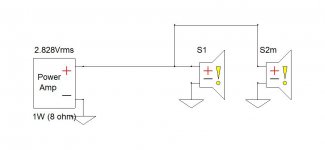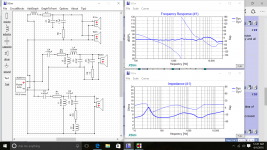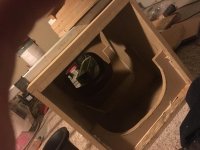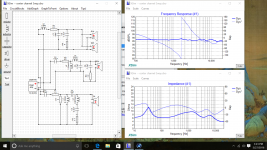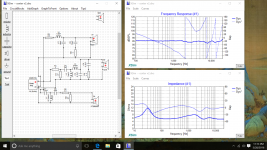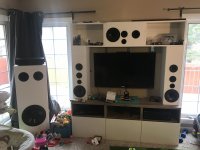With the two woofers in series it seems odd that the impedance is so low. I'll have to rerun the program but I don't remember being able to do a whole lot that made the woofer impedance rise. I'm fairly confident it'll be easy to make a tweak to raise the midwoofer impedance.
I also don't know the effects of phase matching on speakers or what I should be looking for. I'll add the distance you talked about.
Hi Danfuls,
The midwoofer probably has a cap to ground with a resistor in series. That resistor could be increased.
So I'm not sure about the program you are using, but please grab XSim to understand phase and distance matching.
Put together a very simple schematic with two drivers in parallel, like this:

On one of the drivers, select "Tune" and then in "mod delay" enter "1 [in]"
Watch what happens to your Frequency response plot with and without that delay. 🙂
This matters because with traditional box-shaped cabinets the drivers are all attached on the same plane, but the acoustic start of the signal is actually close to the magnet.
So in a two way system, the tweeter's signal is about 1.2" or more closer to your ear than the woofer. This mismatch must be taken into account in your crossover or you will suffer terrible frequency response as a result.
XSim is a great way to play with this and understand "real" vs. "ideal" crossovers. Other tools will also show you this, I just don't know them.
Best,
Erik
The midwoofer probably has a cap to ground with a resistor in series. That resistor could be increased.
So I'm not sure about the program you are using, but please grab XSim to understand phase and distance matching.
Put together a very simple schematic with two drivers in parallel, like this:
On one of the drivers, select "Tune" and then in "mod delay" enter "1 [in]"
Watch what happens to your Frequency response plot with and without that delay. 🙂
This matters because with traditional box-shaped cabinets the drivers are all attached on the same plane, but the acoustic start of the signal is actually close to the magnet.
So in a two way system, the tweeter's signal is about 1.2" or more closer to your ear than the woofer. This mismatch must be taken into account in your crossover or you will suffer terrible frequency response as a result.
XSim is a great way to play with this and understand "real" vs. "ideal" crossovers. Other tools will also show you this, I just don't know them.
Best,
Erik
Attachments
Hi Danfuls,
I think something got messed up in the translation. 🙂
Plot the individual tweeter and midrange drivers in your FR plot, you'll probably see that the midrange low pass filter is too high. I did notice however that your minimum impedance is much better.
Also, use the ground symbol liberally! 🙂 Look at my schematic. Those little triangles reduce the wiring in the schematic by creating a virtual net which are all connected without actually having to draw the wire.
Best,
Erik
I think something got messed up in the translation. 🙂
Plot the individual tweeter and midrange drivers in your FR plot, you'll probably see that the midrange low pass filter is too high. I did notice however that your minimum impedance is much better.
Also, use the ground symbol liberally! 🙂 Look at my schematic. Those little triangles reduce the wiring in the schematic by creating a virtual net which are all connected without actually having to draw the wire.
Best,
Erik
Also, just remember my numbers are suggested kind of sort of averages. I wanted you to get a feel for why they were important, not rely on them to buy parts. 🙂
For the real work you'll need to measure the actual offsets. Please see my blog here for step by step instructions.
For the real work you'll need to measure the actual offsets. Please see my blog here for step by step instructions.
I've been busy with other things preparing for a newborn. He was born yesterday happy and healthy. I finished most of the subwoofer besides painting and filling. Its net internal is 8.5 cubic feet for the Dayton rss390hf. It should provide some really good bass. I'm going to start building the Daedalus' when I leave the hospital with all my vacation time I'm taking. I'm going to build the center next. I worked out a good model for the center, but I was wondering what the cheapest way to test my center build crossover is as I'm building it? I've already sunk a bunch of cash on a the components and will need to buy a bunch of diapers.
Attachments
Danfuls,
Looking at your last schematic I'd say your still not ready to purchase. That treble response needs more help, or a different tweeter. 🙂
Fill us in if you've made changes.
Best,
Erik
Looking at your last schematic I'd say your still not ready to purchase. That treble response needs more help, or a different tweeter. 🙂
Fill us in if you've made changes.
Best,
Erik
Oooh la la! nice fr and quite usable impedance.... but,
Typically the L pad comes last. this lets you adjust leve without reworking the entire filter.
Also, no need to bring the tweeter imp down to 4. 8ish is better on the amp.
Typically the L pad comes last. this lets you adjust leve without reworking the entire filter.
Also, no need to bring the tweeter imp down to 4. 8ish is better on the amp.
I appreciate all your help, especially Erik. I've had this done since July. The side speakers ended up being an original design, and I brought them to Midwest Audio Fest. I am very happy with the set up. the center channel is a little to high off the ground, but it is slightly angled downward. I still need to finish the surround and rear channels for the 7.1 setup. I thought I would post this pic because I got a lot of help from this community on the design.
Thanks,
Dan
Thanks,
Dan
Attachments
- Status
- Not open for further replies.
- Home
- Loudspeakers
- Multi-Way
- Center help
